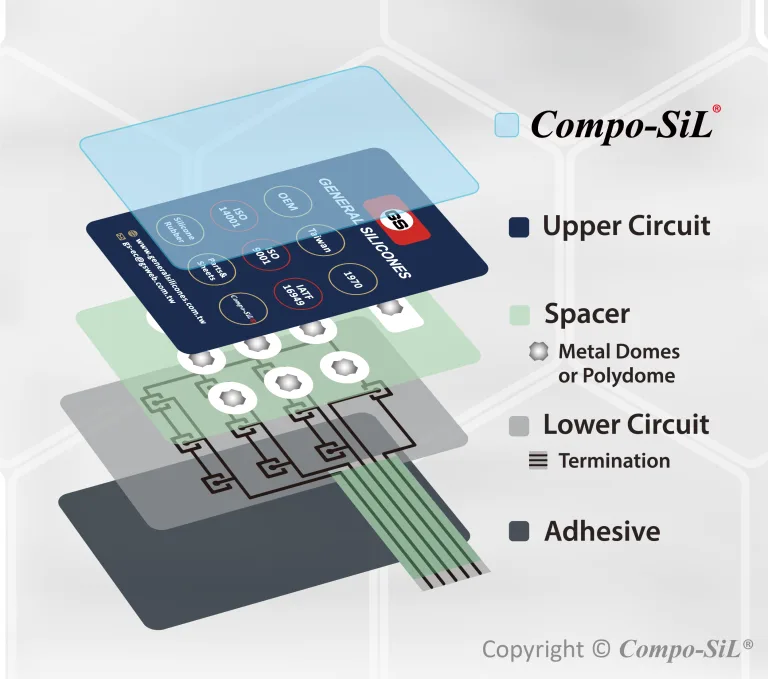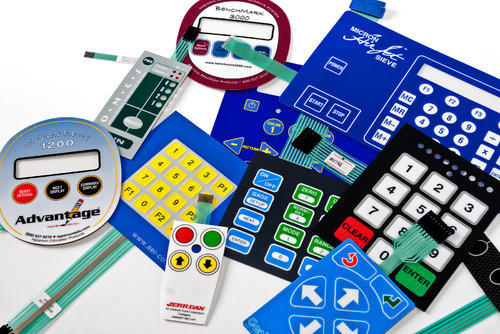Discover Custom Printing and Graphic Overlay Options for Membrane Switches
Wiki Article
Membrane Switches Explained: A Comprehensive Overview to Their Benefits
Membrane layer switches over represent a functional and advanced option for developing user interfaces across a range of industries. Their multilayered design not just guarantees capability via simple stress but additionally provides considerable benefits, such as resilience and modification. As sectors increasingly seek efficient and trustworthy control interfaces, understanding the particular benefits and applications of membrane switches becomes vital. The ins and outs of their design and implementation existing one-of-a-kind difficulties that advantage closer examination. What variables should be taken into consideration to completely leverage their possibility in contemporary applications?What Are Membrane Layer Switches?

When pressure is related to the membrane layer button, the layers make call, finishing an electric circuit. This basic mechanism enables a vast array of applications, from customer electronic devices to commercial machinery. Membrane layer switches are commonly created to be water resistant and immune to dirt and contaminants, making them ideal for environments where durability is essential.
In addition, the versatility of the products made use of in membrane switches over facilitates innovative styles that can adjust to numerous forms and measurements. This versatility adds to their appeal in varied areas, consisting of medical tools, vehicle controls, and home appliances. Generally, membrane changes stand for a crucial component in contemporary customer interface innovation, bridging the space between individuals and electronic systems.
Secret Advantages of Membrane Buttons
Among the myriad of interface alternatives available, membrane changes stand apart for their unique mix of benefits. One of the key benefits is their lightweight and small style, which permits for assimilation into a variety of devices without including significant bulk. This is especially helpful in applications where room is restricted.Additionally, membrane changes offer resilience and resistance to environmental elements. They are typically created with products that can endure wetness, dirt, and numerous chemicals, making them suitable for severe conditions. This durability adds to a longer life expectancy contrasted to traditional mechanical switches.
An additional significant benefit is the convenience in personalization. Membrane layer buttons can be published with various graphics, colors, and textures, enabling for tailored designs that satisfy certain branding or functional demands. This adaptability includes the variety of layers and circuit options, offering designers with numerous setups.
Moreover, the tactile feedback given by some membrane layer changes improves user experience, making them much more instinctive to operate. Last but not least, the simplicity of cleaning and upkeep additionally strengthens membrane buttons as a functional selection in both customer and commercial applications. Membrane Switches. On the whole, these key advantages make them a favored solution for several developers and suppliers
Applications in Different Industries
Just how do membrane buttons locate their area throughout diverse sectors? Their convenience and performance make them important components in industries more varying from healthcare to customer electronic devices. In clinical devices, membrane buttons are utilized for their convenience of cleaning and resistance to contamination, ensuring health in atmospheres where sterility is vital.In the customer electronics industry, these switches offer streamlined, easy to use interfaces that improve product appearances while keeping sturdiness against damage. Automotive applications profit from membrane layer switches too, where they are used in control panels and control board, providing trusted efficiency in challenging problems.
Furthermore, industrial machinery uses membrane buttons for control panels because of their effectiveness, ability to hold up against extreme environments, and customizable styles that deal with particular functional demands. The food market leverages membrane buttons for their convenience of use and resistance to spills, making certain functional performance in busy settings.
Eventually, the adaptability of membrane layer switches across these diverse applications underscores their necessary function in modern-day innovation, boosting individual communication while meeting industry-specific demands. Their continued development assures more assimilation right into arising fields and ingenious items.
Layout and Modification Options
The layout and personalization alternatives offered for membrane layer switches are essential for customizing interfaces to meet certain customer demands and aesthetic choices. These buttons can be designed in numerous shapes, sizes, and formats, enabling seamless assimilation into diverse applications. The adaptability in layout means that producers can produce special interfaces that improve use and keep brand identity.Personalized colors, graphics, and textures can be related to the surface area of the membrane layer switch, giving a possibility for branding and user involvement. Furthermore, backlighting options, such as LED lighting, can be incorporated to improve presence in low-light problems, therefore improving capability.
Functional components can also be personalized, including useful content responsive feedback and actuation force, which can be readjusted to match various customer interactions. The option of materials, such as polyester or polycarbonate, allows for variants in resilience and ecological resistance, dealing with the specific needs of different markets.
Eventually, the extensive style and customization abilities of membrane buttons make it possible for business to create aesthetically attractive and straightforward interfaces, ensuring that their items satisfy both practical and visual needs effectively. Membrane Switches.
Considerations for Application
Carrying out membrane layer switches calls for careful consideration of different aspects to make sure ideal performance and individual experience. Factors such as direct exposure to moisture, extreme temperature levels, and chemical materials can substantially impact the switch's performance and durability.
One more vital element is the button's layout and design. Making certain that the responsive comments and actuation pressure align with customer assumptions enhances use. Carrying out individual testing can provide valuable understandings into the optimum layout.
Additionally, compatibility with digital elements have to be analyzed. The switch's circuitry need to line up with the overall system design, making certain trustworthy signal transmission and minimizing interference.
Moreover, production approaches and prices must be reviewed. The choice between customized styles and common models can lead and affect both budget time.
Last but not least, take into consideration repair and maintenance. Membrane buttons might call for particular cleaning and treatment treatments to preserve their appearance and capability in time. By addressing these considerations, organizations can carry out membrane buttons that meet their functional requirements while supplying a positive user experience.

Verdict
In conclusion, membrane changes stand for a long lasting and flexible control user interface ideal for a large array of applications throughout numerous sectors. Membrane Switches. As modern technology continues to evolve, the relevance of membrane switches in contemporary devices continues to be substantial, using both capability and aesthetic appeal.Membrane changes stand for a sophisticated and functional remedy for creating customer interfaces throughout a selection of sectors.Understanding the basic parts of contemporary electronic user interfaces, membrane buttons are a type of customer interface tool that consist of flexible, thin layers of material. In general, membrane layer switches stand for an important component in modern-day user interface modern technology, bridging the space between users and digital systems.
Among the myriad of user interface choices readily available, membrane layer switches stand out for their distinct mix of advantages.The style and personalization options offered for membrane layer switches are vital for customizing interfaces to meet particular customer other needs and aesthetic preferences.
Report this wiki page